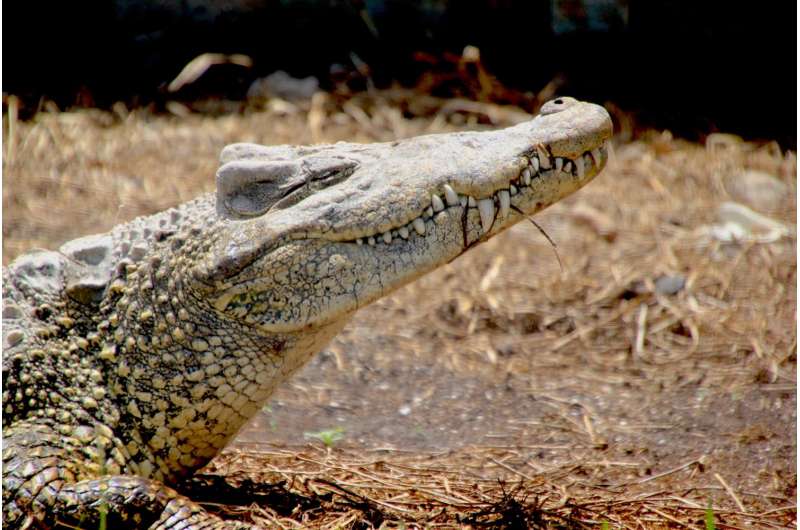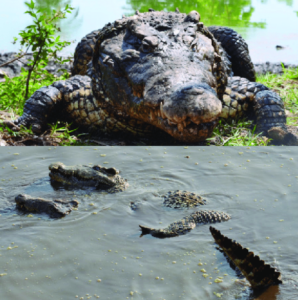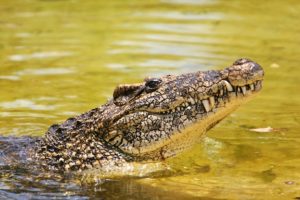THE CUBAN CROCODILE (Crocodylus rhombifer) is LISTED AS A “CRITICALLY ENDANGERED” SPECIES.
Being too coveted as a mating partner can have its downside for a species faced with extinction, as the Cuban crocodile has learned.
Arduous pursuit by its amorous American counterpart has seen survival of the island species, its numbers already dwindling, further threatened by hybridization. According to the International Union for Conservation of Nature (IUCN), the Cuban crocodile population has declined more than 80 percent over three generations.
Hybridization is one of the main threats to its survival, according to the IUCN, along with hunting for meat—in large part for tourist restaurant menus.
Known to scientists as Crocodylus rhombifer, the black-and-yellow freshwater reptile is listed as a “critically endangered” species.
VIDEOS- Cuban Cocodryle Documentary (Trailer)..
Cuban crocodiles face other threats, such as an increase in illegal hunting in recent years, so the release of captive-bred Cuban crocodiles and the protection of these reptiles from poaching and hybridization is critical to the survival of the species in the wild.
Today, the scaly predator’s island-wide range has been largely limited to the Zapata Swamp some 150 kilometers (93 miles) southeast of Havana.
The critically endangered Cuban crocodile has the smallest, most-restricted geographic distribution among all living crocodilian species, is only found in parts of the Zapata and Lanier swamps. Historically it was found throughout the Zapata Peninsula, but indiscriminate hunting for skins beginning in the second half of the 19th century and lasting until the early 1960s decimated most populations.
Today, Cuban crocodiles inhabit a territory of about 77,600 hectares (191,700 acres), sharing habitat with the American crocodile and the hybrids of both species.
But it is not alone.
The American Crocodylus acutus, a fresh- and saltwater specimen, is also found here, and seems to enjoy the company of its Cuban counterpart—perhaps a little too much. Already at the Zapata natural reserve, one in two crocs is a hybrid, conservationists say.
The Cuban crocodile lives in freshwater and is smaller and more aggressive than its American counterpart.
Natural or not?
But gene mixing may not necessarily be a bad thing.
“One has to remember that hybridization also plays a role in evolution, in the appearance of new species,” said Etiam Perez-Fleitas, an exotic species expert at the Zapata reserve.
The question for scientists now is whether this particular mixing of the gene pool is good or bad.
If the phenomenon is the result of human-induced stresses, it has to be stopped, explained Perez-Fleitas. But if it is natural, it might be best to leave it well alone.
As sometimes happens naturally, hybridization could result in a more resistant species, combining the aggression of the smaller Cuban crocodile and the adaptability of its more timid American cousin.
The American crocodile, listed as “vulnerable” by the IUCN, is native to countries of northern South America, the Caribbean, Central America, and the tip of Florida.
In the meantime, a 2008 genetic study has allowed scientists to distinguish Cuban crocs from hybrids, and to exclude the latter from captive breeding programs.
AT THE ZAPATA SWAMP RESERVE…
At the Zapata reserve, some 500 to 1,000 baby Cuban crocs are born into semi-captivity every year, of which about a hundred are released into the wild.
AFP visited the project on a day when workers were collecting eggs from croc nests to be placed in an incubator—which vastly improves their chances of hatching.
It is a risky business, and five men with large sticks surrounded the nest mound as another dug for eggs, ready to repel a sudden toothy attack from the water or the tall grass nearby.
Each female lays about 20 to 40 eggs, which spend some 80 to 85 days incubating.
Zapata reserve employee Jorge Luis Monero, 56, holds a young specimen measuring about half a meter in his arms and insists its profile is reminiscent of the distinctive elongated shape of the island of Cuba.
“In the Americas, there is no other crocodile-like the Cuban,” he said.
But in spite of the animal’s uniqueness, Perez-Fleitas said preserving a pure breed is not necessarily the best option, and cautioned against deciding too hastily on the way forward.
When dealing with a creature that can live up to 70 years in captivity, it is better to have “very long-term plans,” the specialist said.
“Maybe in 100 years, it will be the hybrids that need protecting,” he added.
WCS’s Cuba Program has helped establish strong collaborations in the pursuit of safeguarding the island nation’s wildlife and natural resources. In addition to working to conserve both Cuban and American crocodiles in Zapata and Birama Swamps, WCS has helped protect raptors in the inland forests of eastern Cuba and shark species inhabiting the rich coastal waters of Jardines de la Reina National Park.
WCS-Cuba has partnered with national agencies to help train three generations of conservation educators and decision-makers through professional exchanges and applied ecological teaching and worked to balance conservation with support for local livelihoods and culture.
EL COCODRILO CUBANO (Crocodylus rhombifer) ESTÁ LISTADO COMO ESPECIE “EN PELIGRO CRÍTICO”
Ser demasiado codiciado como compañero de apareamiento puede tener sus inconvenientes para una especie que se enfrenta a la extinción, como ha aprendido el cocodrilo cubano.
La ardua búsqueda por parte de su amorosa contraparte estadounidense ha hecho que la especie de la isla sobreviva, sus números ya están disminuyendo, aún más amenazados por la hibridación. Según la Unión Internacional para la Conservación de la Naturaleza (UICN), la población de cocodrilos cubanos ha disminuido más del 80 por ciento en tres generaciones.
La hibridación es una de las principales amenazas para su supervivencia, según la UICN, junto con la caza por su carne, en gran parte para los menús de los restaurantes turísticos.
Conocido por los científicos como Crocodylus rhombifer, el reptil de agua dulce negro y amarillo está catalogado como una especie “en peligro crítico”.
VIDEOS- El Cocodrilo Cubano ( Documental)..
Los cocodrilos cubanos enfrentan otras amenazas, como un aumento en la caza ilegal en los últimos años, por lo que la liberación de cocodrilos cubanos criados en cautiverio y la protección de estos reptiles contra la caza furtiva y la hibridación es fundamental para la supervivencia de la especie en la naturaleza.
Hoy en día, el área de distribución del depredador escamoso en toda la isla se ha limitado en gran medida a la Ciénaga de Zapata, a unos 150 kilómetros (93 millas) al sureste de La Habana.
El cocodrilo cubano, en peligro crítico de extinción, tiene la distribución geográfica más pequeña y restringida entre todas las especies vivas de cocodrilos, solo se encuentra en partes de los pantanos de Zapata y Lanier. Históricamente se encontraba en toda la península de Zapata, pero la caza indiscriminada de pieles a partir de la segunda mitad del siglo XIX y hasta principios de la década de 1960 diezmó la mayoría de las poblaciones.
Hoy, los cocodrilos cubanos habitan un territorio de unas 77.600 hectáreas (191.700 acres), compartiendo hábitat con el cocodrilo americano y los híbridos de ambas especies.
Pero no está solo.
El Crocodylus acutus americano, un espécimen de agua dulce y salada, también se encuentra aquí y parece disfrutar de la compañía de su contraparte cubana, quizás demasiado. Ya en la reserva natural de Zapata, uno de cada dos cocodrilos es un híbrido, dicen los conservacionistas.
El cocodrilo cubano vive en agua dulce y es más pequeño y agresivo que su contraparte estadounidense.
¿Naturales o no?
Pero la mezcla de genes puede no ser necesariamente algo malo.
“Hay que recordar que la hibridación también juega un papel en la evolución, en la aparición de nuevas especies”, dijo Etiam Pérez-Fleitas, experto en especies exóticas de la reserva Zapata.
La pregunta para los científicos ahora es si esta mezcla particular del acervo genético es buena o mala.
Si el fenómeno es el resultado de tensiones inducidas por el hombre, hay que detenerlo, explicó Pérez-Fleitas. Pero si es natural, lo mejor es dejarlo así.
Como a veces sucede naturalmente, la hibridación podría resultar en una especie más resistente, combinando la agresión del cocodrilo cubano más pequeño y la adaptabilidad de su primo americano más tímido.
El cocodrilo americano, catalogado como “vulnerable” por la UICN, es originario de países del norte de Sudamérica, el Caribe, Centroamérica y la punta de Florida.
Mientras tanto, un estudio genético de 2008 ha permitido a los científicos distinguir los cocodrilos cubanos de los híbridos y excluir a estos últimos de los programas de cría en cautiverio.
EN LA RESERVA CIÉNDRADA DE ZAPATA…
En la reserva de Zapata, cada año nacen en semicautiverio entre 500 y 1.000 cocodrilos cubanos bebés, de los cuales alrededor de cien son liberados en la naturaleza.
AFP visitó el proyecto un día en que los trabajadores recolectaban huevos de los nidos de cocodrilos para colocarlos en una incubadora, lo que mejora enormemente sus posibilidades de eclosión.
Es un negocio arriesgado, y cinco hombres con grandes palos rodearon el montículo del nido mientras otro cavaba en busca de huevos, listo para repeler un ataque repentino de dientes del agua o de la hierba alta cercana.
Cada hembra pone entre 20 y 40 huevos, que tardan entre 80 y 85 días en incubarse.
El empleado de la reserva de Zapata, Jorge Luis Monero, de 56 años, sostiene un espécimen joven que mide alrededor de medio metro en sus brazos e insiste en que su perfil recuerda la distintiva forma alargada de la isla de Cuba.
“En América no hay otro cocodrilo como el cubano”, dijo.
Pero a pesar de la singularidad del animal, Pérez-Fleitas dijo que preservar una raza pura no es necesariamente la mejor opción, y advirtió que no se debe decidir demasiado apresuradamente el camino a seguir.
Cuando se trata de una criatura que puede vivir hasta 70 años en cautiverio, es mejor tener “planes a muy largo plazo”, dijo el especialista.
“Tal vez en 100 años, serán los híbridos los que necesiten protección”, agregó.
El Programa Cuba de WCS ha ayudado a establecer colaboraciones sólidas en la búsqueda de salvaguardar la vida silvestre y los recursos naturales de la nación isleña. Además de trabajar para conservar los cocodrilos cubanos y americanos en los pantanos de Zapata y Birama, WCS ha ayudado a proteger a las aves rapaces en los bosques del interior del este de Cuba y a las especies de tiburones que habitan las ricas aguas costeras del Parque Nacional Jardines de la Reina.
WCS-Cuba se ha asociado con agencias nacionales para ayudar a capacitar a tres generaciones de educadores en conservación y tomadores de decisiones a través de intercambios profesionales y enseñanza ecológica aplicada y ha trabajado para equilibrar la conservación con el apoyo a los medios de vida y la cultura locales.
Agencies/ Wiki/ PHYSORG/ Katell Abiven/ WildLifeConsScy/ Extractos/ Excerpts/ Internet Photos/ YouTube/ Arnoldo Varona/ www.TheCubanHistory.com
THE CUBAN HISTORY, HOLLYWOOD.










